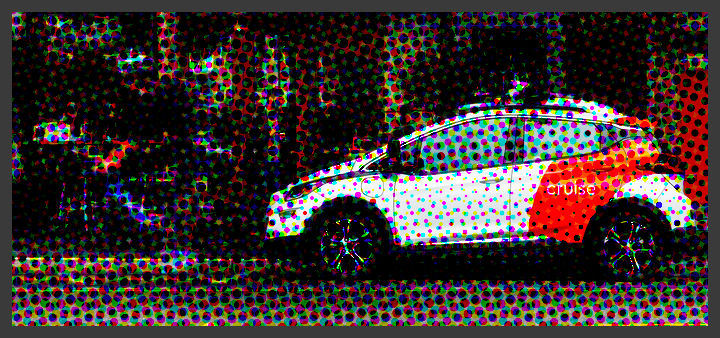Driverless cars, but…

To the car enthusiasts and car bros: set aside, for a moment, your countless hours of driver training, years without accidents, number of press vehicles driven or international experience. I’m the driver now. Tesla stans, sit on your hands too.
I won’t bore you with my personal history with cars, but let’s assume for a moment I’ve read and absorbed as much as possible on the automobile and its autonomous potential, and I’ll assume you’re an equally smart cookie.
Now, let us consider the big one:
Why are autonomous cars perceived as the solution to many of our transportation problems by the powers that be?
Money, obviously. Never before have we been able to commercialize roads at a global scale, and all that may entail.
We can build toll bridges and adopt highways, drive advertisements through Times Square, claim parking spots for beer gardens and build member’s only race tracks, but those are small peanuts compared with the money making potential of turning our roads and the vehicles on them into a service.
What a service it’ll be! For those who don’t drive, for overall safety, efficiency, and environmental reasons, I think the best-touted aspects of autonomous vehicles may one day, somewhere, shine through. It’s no question that their development (and the various leaps forward in technology they’re built upon) is a worthy use of time and money.
Besides.
Any driver-less solutions come with problems: software can be buggy, hackable, and exploitable; the companies that develop it can be nearsighted, greedy, and negligent. User safety is still a dangerous unknown that will disproportionately affect the most vulnerable. Y’know, those who need safe and affordable transportation the most.
If software and their companies can’t be wholly trusted act in our best interests and we’ve demonstrated we can’t, either, is there another option?
Easy! We just need to practice. We need to become better drivers to ensure our roads and vehicles stay free from unwanted outside control.
Pour billions of dollars in public and private investment into the idea we’re able to level up millions of drivers with a curriculum that stamps out the temptation to speed, txt, be distracted, late, tired, angry—plus able to react to acts of God, as they say. This also requires owners to fully maintain their vehicles.
In this future, we’re all Sir Lewis Hamilton.
How likely is this? Sadly, not one bit.
New consumer automotive technology most often adopts the “trickle-down” approach, where advanced features and capabilities enter (at a huge cost) at the top of the market before filtering across the cars normal people get to drive.
The Anti-Lock Braking System (ABS), for instance, debuted on airplanes, then on racing cars where professional drivers were able to eek out a significant advantage over the competition. Roadgoing all-wheel-drive, turbocharging, navigation systems, and so on – most often what paves the way forward appears as part of a halo product.
A key here is to be a technology that people want, not that they feel stuck with.
Like all of the above, driverless technology needs to be reframed as a halo product—the current approach is not working. Similar to modern hybrid tech that eventually jumped from the Toyota Prius (1997) to Formula 1 (2014) and is now accepted for commuter and performance cars alike, surrendering control to a vehicle must be a feature…not a bug.
To me, driverless and autonomous technology makes most sense as a suite of features to enable on luxury, exotic, and super-class cars.
As in: you must prove you’re able to safely operate a vehicle at a high level before earning the ability for your Tesla to autonomously whisk you to the airport.
Allow me to state the obvious: the ability to travel at highway speeds with little driver input should be in the hands of those who are least dependant on an algorithm to keep them under control.
I’ve thought of several more compelling reasons why this all makes sense, but my favourite remains the potential for vehicles that drive themselves with code designed to delight, not ones programmed a step below the lowest common denominator.
Low-level autonomous functions could include automatic lane changes, radar cruise control, self-parking functions, and possibly even a vehicle “fetch” function.
High-level functions would cover code with the most potential for human harm: highway driving, dialling up a deceased rally driver for backroad fun, or allowing random cars to safely follow as needed, platooning under your control.
How? Roughly:
- Create a universal (international) app or enhanced license that drivers use to authenticate themselves with *any* machine featuring these capabilities; I loathe this step, however, there are often classes for chauffeurs, truck drivers, motorcycles, and so on—this is not too different.
- Establish a method of testing potential drivers, which could be as simple as using logging software to verify their everyday driving before enabling basic autonomous functions or manufacturers adapting their already extensive driver training programs to allow customers to learn and be tested on more advanced skills
- Discourage misuse with ludicrous fines and penalties
As far as consumer-facing tech is concerned, the Western automotive industry is late-stage clicker, early-stage home automation: addicted to oversized buttons and now reluctantly texting with its thumbs.
Worse, autonomous technology is already locked, Krakken-style, into many automakers’ future (read: ever-changing) product plans, plans often dependent on mass production of this technology, cost reductions, and so on to ever be adopted in great numbers.
So it’ll be a total gong show.
Tesla, of course, is the one automaker that bucks this trends and pushes forward seemingly as the first icebreaker – earning the sweet-and-sour mix of bragging rights, a market advantage, human deaths, and a chorus of negative press.
It has mostly been a gong show.
Sadly, we have already had the first pedestrian killed by an autonomous vehicle—somewhat ironically, a Volvo that had been modified by Uber for driverless (but driver-attentive) operation.
The fatal Uber crash showed a few chilling frames of inattention—the driver looking at her phone—before 49-year-old Elaine Herzberg was struck and killed by the Volvo after she stepped out to cross the street in Tempe, Arizona.
Counterpoint.
What if each news report concerning autonomous incidents started with a disclosure that the driver had been highly trained and the crash was, in fact, a freak and unavoidable accident…not a depressingly sad one involving an innocent woman who died at the hands of an autonomous Uber. Allegedly.
Governments, how about starting with these scripts –
- To automakers and software companies: “If you want autonomous anything on the road, put it under a digital lock to be opened only by the best drivers we have.”
- To drivers: “If you want to use this stuff you’ll have to prove your abilities, pay a big surcharge, and sign an insurance waiver as long as your arm.”
I guess: brush up on your j-turns and start saving for a few days of advanced driving instruction? Think passenger jet airliner autopilot: to engage it, first you must be an actual pilot.
I’ve thought of several more compelling reasons why this all makes sense, but my favourite remains the potential for vehicles that drive themselves with code designed to delight, not ones programmed a step below the lowest common denominator.
At their future zenith, I see “autonomous vehicles” not widely adopted as miserly pods but as software and sensors built into vehicles and available to take command or aid operation when necessary.
It’s compelling to dream of a friendly robotic pod that could safely, comfortably whisk my aging grandmother to the doctor…but the reality is that she still uses a rotary phone and has no license.
To get her a driverless ride would involve a smartphone with internet connection, a cell phone number and email for signup, all of the apps required, payment details, plus passwords and touch/face ID protocols set up.
For a ride with a service like Cruise, even if it was available, the barriers to entry are insurmountable for too many.
This technology makes most sense, today and for the next decade, in more professional settings.
Take paramedics: once a patient is in the back and AI is engaged, both could have their attention free to focus on saving a life. An airport shuttle bus driver could take a break, sending his bus to do a loop while he has lunch. Likewise, a long-haul trucker would gain the ability to take more frequent breaks without losing time.
Perhaps professional “platooning” conductors in their vehicles could lead opt-in Interstate conga lines to allow participating drivers to cede control to the conductor for a portion of the journey, each offering a few bucks as a tip for the service.
Finally, the enthusiast driver: wouldn’t it be epic if you could take your new Porsche to any of the world’s race tracks, hit a few buttons, and experience what it would be like in that moment to have a digital Mark Webber take you to the edge of control? More likely: a Dial-A-Webber button to autonomously drive your sleepy ass to the office following last night’s Steely Dan concert.
The rich get richer, have more fun, and could…help?
Road users without autonomous technology, a car or even a bicycle benefit, too: they’d feel confident the operators of autonomous vehicles are paying attention.
After all, to go autonomous, these drivers will have paid for the privilege, they’ll have opted in to the data logging and electronic surveillance that comes with autonomous capabilities, and they’ll have little excuse or recourse if they’re caught using the tech to be stupid. The upside? HAVING A CAR THAT FRICKIN’ DRIVES ITSELF. Whoaaa!
The automotive industry is too old and red-handed to pretend it’s not expected to help solve the many problems in front of us.
Carmakers have made our vehicles smarter than ever—while refusing to acknowledge humanity’s innate desire to master our domains. They’ve added more technology, albeit behind additional layers of complexity and without appropriate training.
They’ve even introduced cars that drive themselves, totally ignoring the upside of augmenting their human operators’ best attributes, instead lulling them to sleep.
I’m optimistic the coming autonomous vehicle revolution will lead to a positive transformation on our roads, but it’s a total toss-up at the moment.
What I do know: the magic, transformative potential of autonomous technology is snuffed when it’s built for the lowest common operators.
-30-



Member discussion